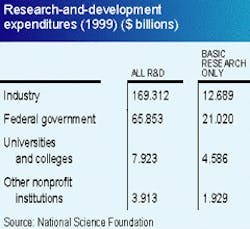Washington Report: Federal government should put on the speed in R&D race
When it comes to industrial research and development (R&D), companies in the United States are pushing on the gas pedal, while the federal government is stuck in neutral, according to a new study from the National Science Foundation (NSF). Industry spent an estimated $169.3 billion on R&D in 1999, up an estimated 10.3% from the previous year, according to the study, released by the foundation in October (see table). That figure includes spending on basic research as well as applied R&D.
Overall, industry, the federal government, universities, and nonprofit organizations collectively will spend $247 billion on R&D in all its forms, according to the study. In other words, all R&D will account for 2.79% of the nation's gross domestic product (GDP), up from 2.67% in 1998. That's the highest percentage for R&D spending since 1967. However, it still places national spending on research and development at a lower level than the 1960s, when the nation went on a burst of spending for science. The record for US expenditures on R&D is 2.87% of the GDP in 1964.
Government share down
Meanwhile, in 1999 the federal government is responsible for 16.7% of the nation's research and development—the smallest proportion since statistics were started in 1953. "Almost all of the recent growth in national R&D expenditures is the result of a resurgence of industrial R&D," notes the report.
Not everyone is happy about that state of affairs. In late September, about 100 university presidents and scholars rallied in Washington under the aegis of the Science Coalition—a group of universities and scientific organizations urging increased federal spending on science and engineering. Earlier this year, the Senate approved a bill that would have doubled federal spending on science over 11 years. But the House Science Committee killed the bill in July.
In August, the Clinton administration chose to seize upon federal funding for science as a key political issue with the Republican Congress. "Scientists and engineers constitute one of the largest, most valuable, yet least heard constituencies in America. Their work makes major contributions to our economy, our national security, and the health and well being of our citizens and our environment," Neal Lane, Clinton's science adviser, said in a statement as the legislature began its August recess. "Our elected representatives need to understand that investments in the future of science and technology are investments in the future of our country and are investments that Americans are willing to make."
Industry vs. government spending
Not surprising, the federal government spends more money on pure basic research—that is, research that is not aimed at a specific commercial application—than does private industry. The federal government devoted $21 billion to basic research in 1999, while industry spent $12.7 billion on basic research, according to the newer NSF report.
The new NSF study does not break down the 1999 figures for private-sector research and development by specific industries. But another foundation study, released in August, did analyze company-funded industrial research and development for 1997, and it suggests that the laser industry, like others, is increasing its R&D investment.
The August 1999 study reported that companies that manufactured "optical, surgical, photographic, and other instruments" conducted $5.2 billion of research and development in 1997, up from $4.9 billion worth of research and development in 1996. When adjusted for inflation, that amounted to a 4.5% increase. Companies that manufacture scientific and mechanical measurement devices spent $3.7 billion, up 11.2%. Meanwhile, companies in the electronic-components sector spent $10.8 billion on research and development in 1997, down 15.3% from the previous year, the NSF study found.
And for those—like many in the laser industry—who are worried about competition from overseas, the new NSF report offers reason to remain jittery. The United States still spends less on nondefense research and development, as a percentage of GDP, than Germany or Japan. That suggests that officials of US companies may want to step on the R&D gas pedals a little harder.
